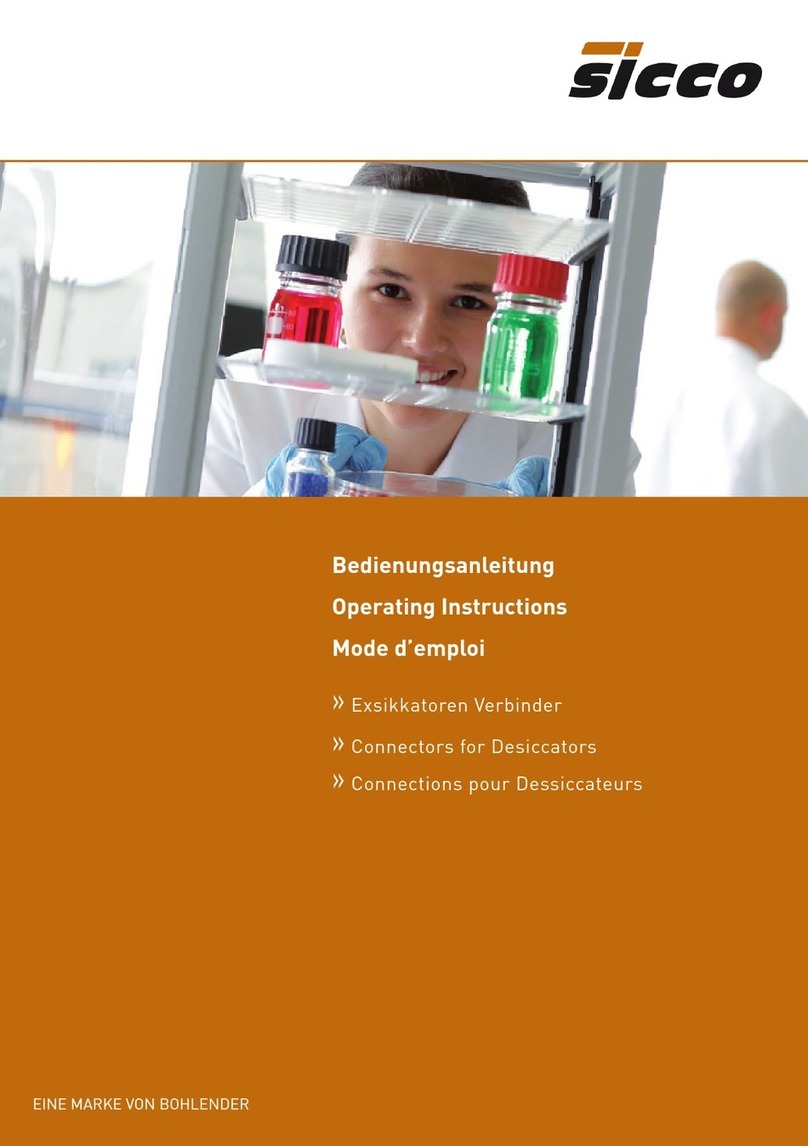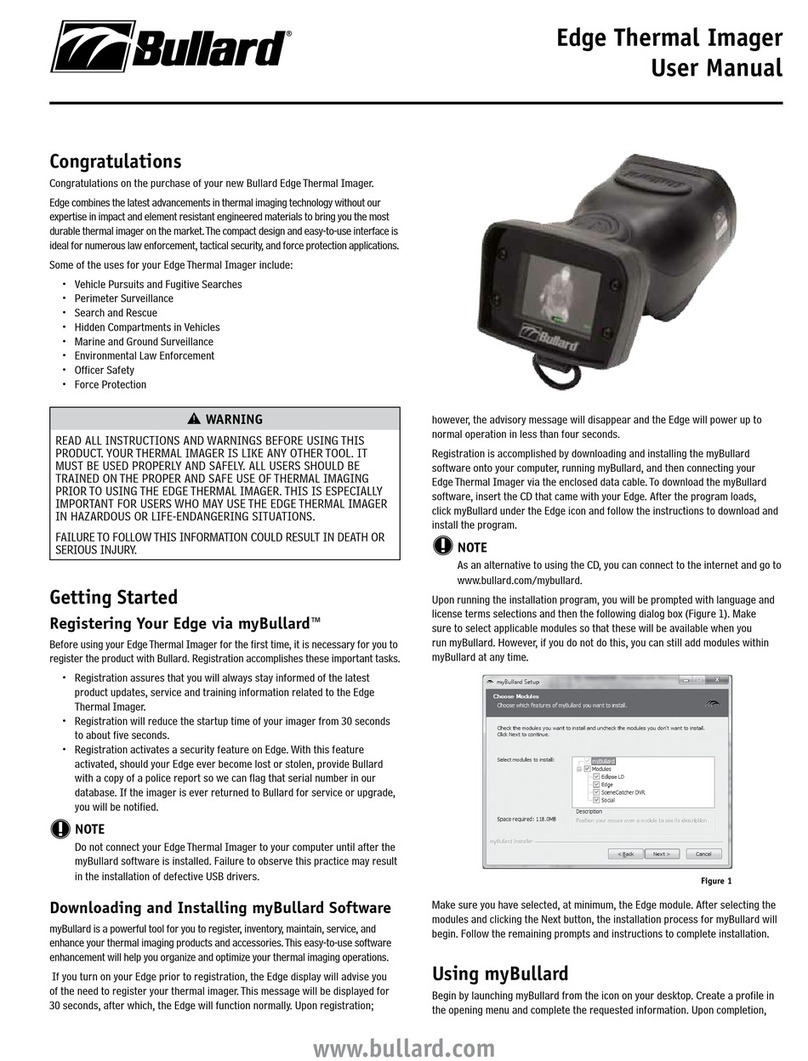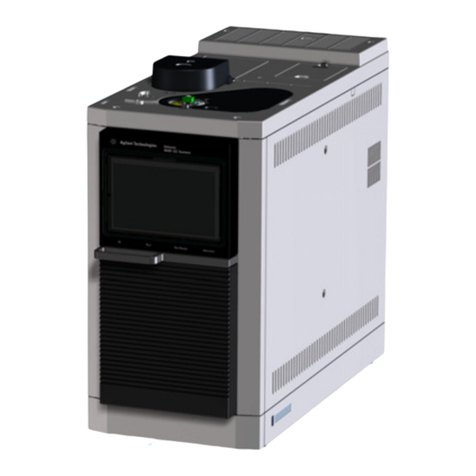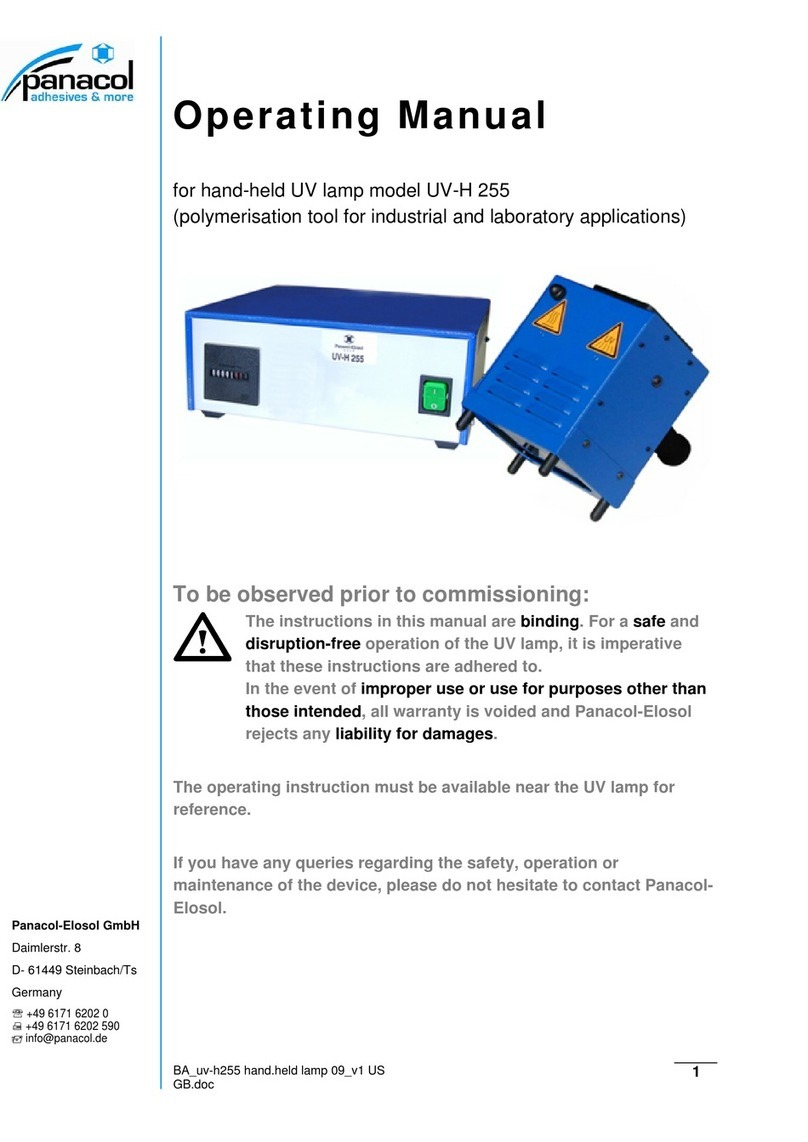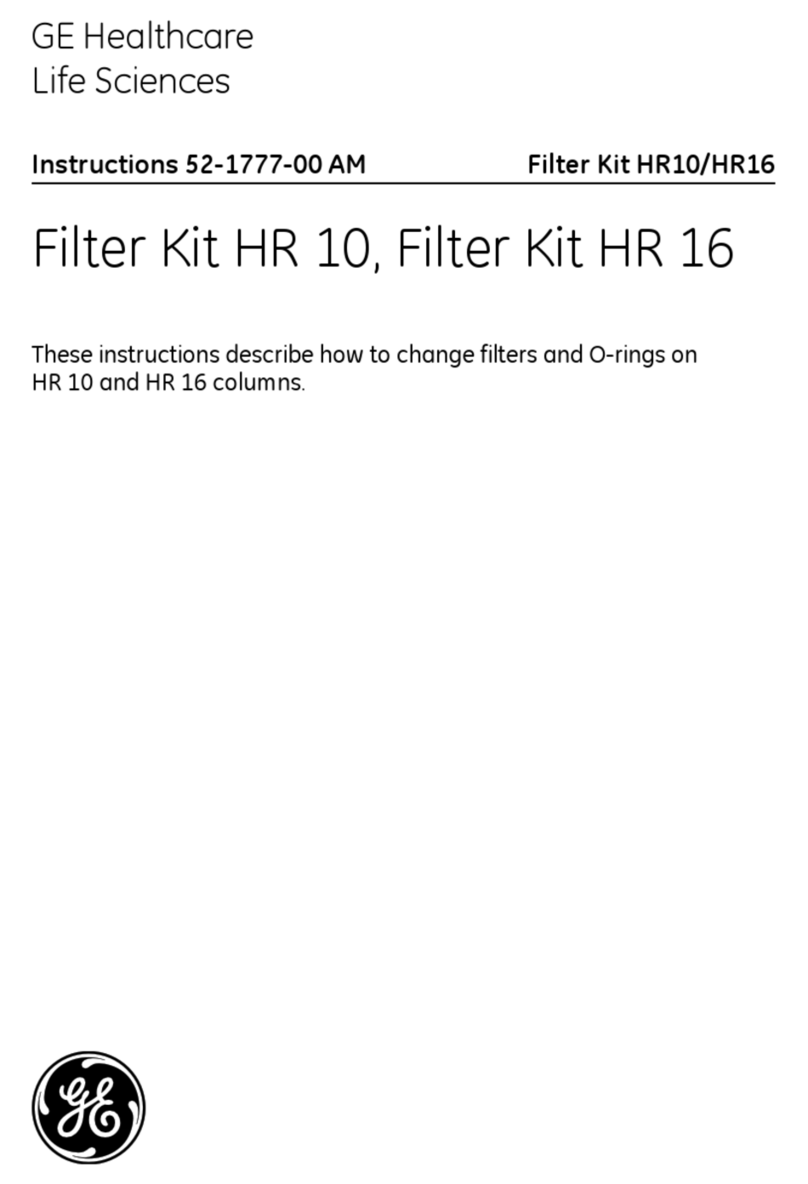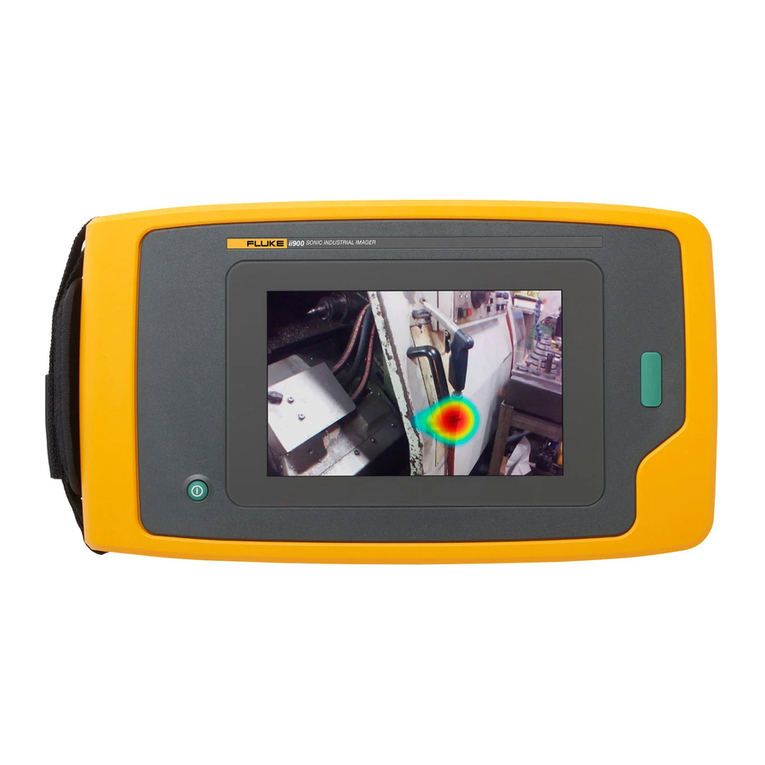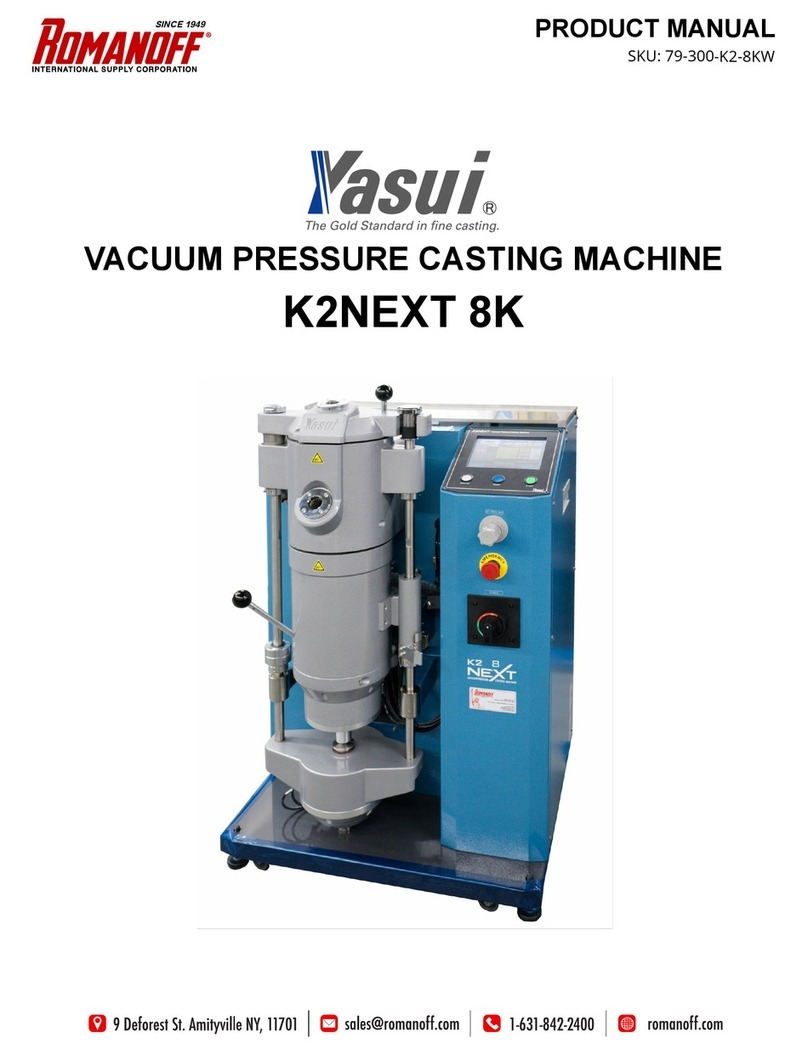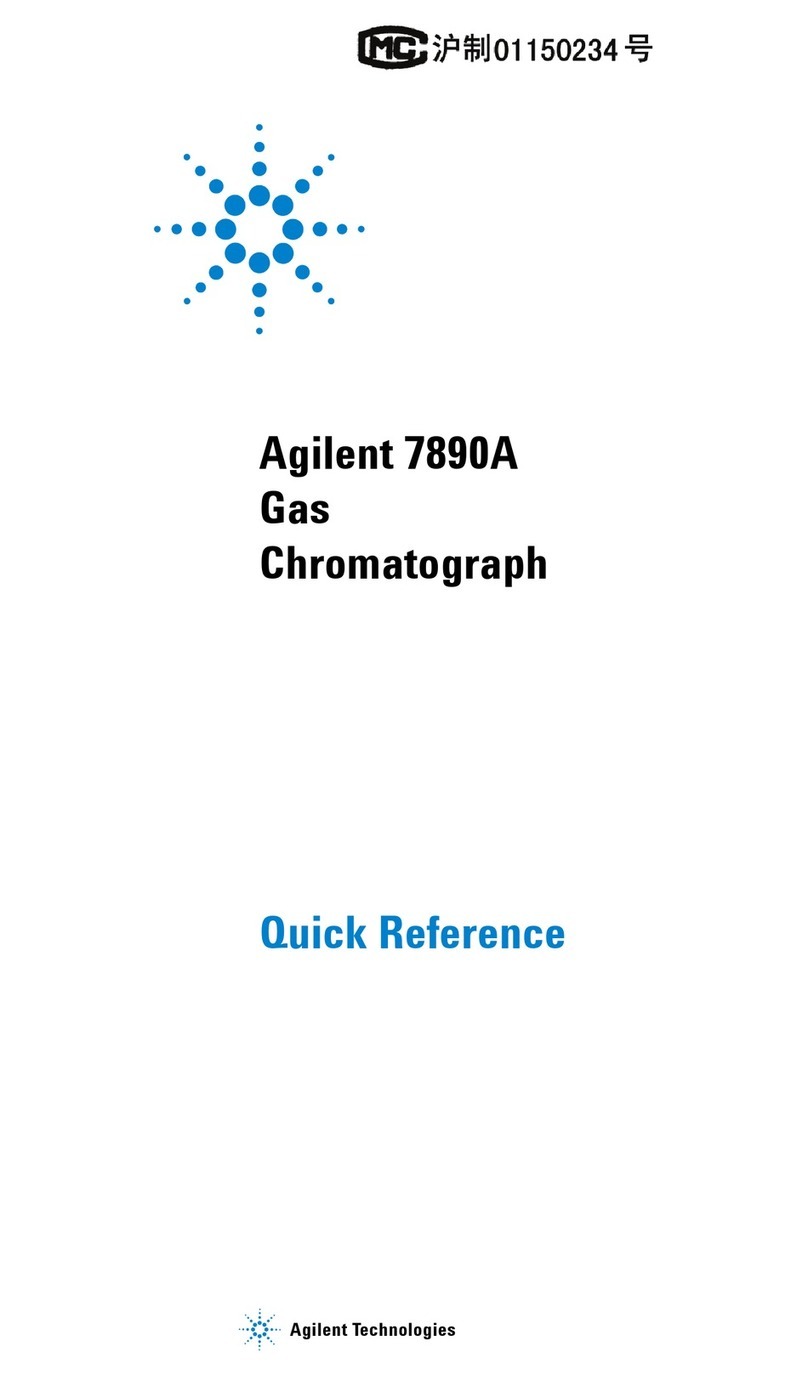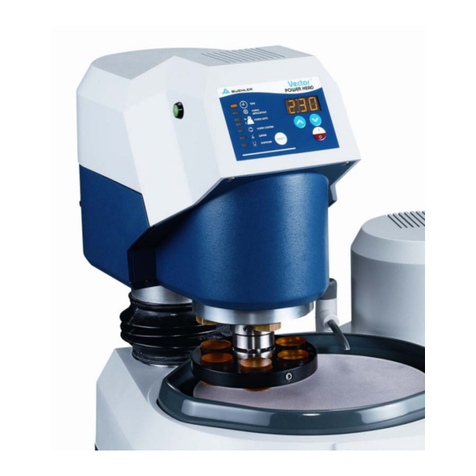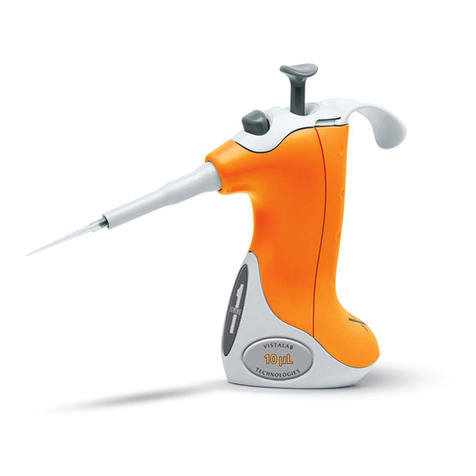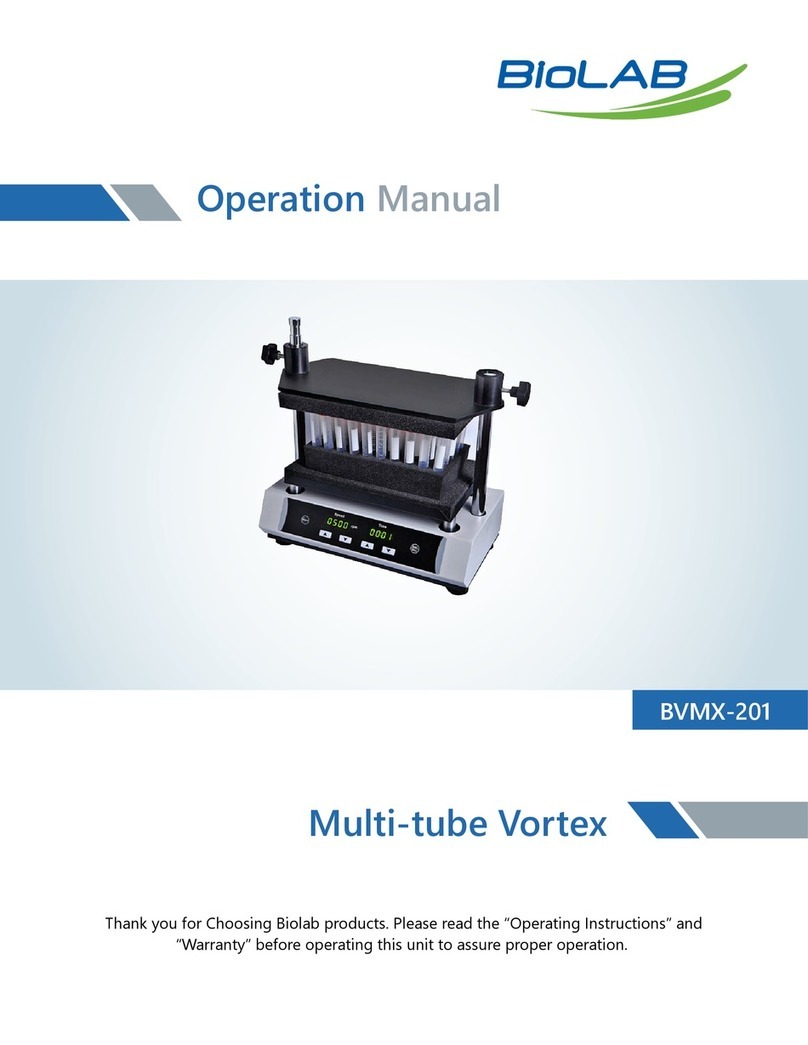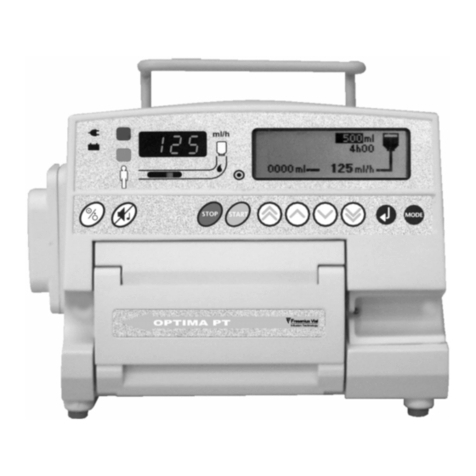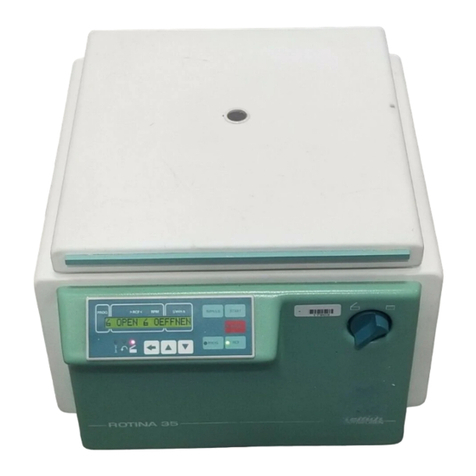Sterylis VS-450 User manual

PROFESSIONAL ROOMSTERILIZERS
MODELS:
VS-450, VS-600, VS-900,
VS-1200 ,VS-1500 AND
VS-1800.
MANUAL
OPERATIONS
pl
Issue number 08042020


3
en
Issue number 08042020
Table of Contents
Notes for service technicians 4
Notes for users 5
Important safety instructions 6
Product features 11
Purpose 11
Product description 11
Operation principle:_ 12
Packing contents: 14
Operation15
Operating the device 15
Control panel 16
Remote control 17
Starting the device and selecting the operating mode 18
Filtration mode 18
UV-C disinfection mode 18
O3 + UV-C sterilization mode 19
Compliance with the ozone concentration limits 19
UV-C disinfection mode (silent) 20
Working time counters 20
Instructions for resetting the general working time counter 20
Instructions for resetting the filter operating time counter / deleting the filter replacement alarm 21
Instructions for resetting the UV lamp counter / resetting the lamp replacement alarm 22
Malfunctions and other indications 23
Testing of control lights 24
Ozone destruction 24
Maintenance 25
Recommendations for maintenance 25
Replacing the filters 25
Replacing the UV-C radiators 26
Replacing the ozone generators 26
Procedure for carrying out the ozoning process 27
Declaration of Conformity 29
Warranty and Service 30

4
en
Issue number 08042020
Notes for service technicians
The following service instructions are intended exclusively for qualified service personnel. To reduce the
risk of danger (electric shock, UV-C exposure, exposure to high ozone concentrations), persons without
appropriate qualifications or without appropriate training should not perform any servicing other than as
described below.
When servicing this appliance, the service technician is exposed to dangerous UV-C radiation, high con-
centration of the hazardous substance ozone and high voltage. The possible effects of exposure to these
dangers and assistance in such cases are described later in the manual. It is essential that you read this
information before you start servicing. It is also recommended to read the safety data sheet before
starting service work.
All service work must be carried out in accordance with the instructions
for service technicians.
The voltage inside the device is high and can cause an
electric shock. This is especially true for the very high voltage generated by the
ozone generators. It is dangerous to touch any parts inside
the device.
The device emits UV-C radiation hazardous to human health.
Never carry out service work with UV lamps running.
The device generates ozone, which is a dangerous substance, can lead to respirato-
ry damage and at very high concentrations is
dangerous for human and animal life. When carrying out maintenance work, do not
put your face close to the ozone generator or inhale the ozone directly from the
generator.

5
en
Issue number 08042020
Notes for users
Proper disposal of this product
1) The STERYLIS room steriliser can emit health hazardous UV-C radiation and generate high ozone
concentrations. For this reason, please read these operating instructions very carefully, especially
the chapter on safety!
2) Keep this manual and store it in a safe place.
3) Special attention should be paid to the information specified in the grey fields with the warning sign
and those in bold.
4) Follow the instructions.
5) In case of detection of malfunctioning of the device, contact the manufacturer's service department
or directly the manufacturer.
6) For additional information not included in this manual, please contact the manufacturer directly.
7) It is essential that you read the meaning of the following warning icons. They are located in the
manual, on the housing of the device or on other parts of the steriliser and are directly related to it:
SYMBOL MEANING SYMBOL MEANING
Important safety instruction.
Be sure to read it!
The device generates ozone,
which is classified as a
dangerous substance.
Warning, high voltage!
The device generates ozone,
which can
lead to airway
damage.
Dangerous UV-C radiation
inside the device.
The device generates ozone,
which in very high concen-
trations can lead to death or
serious damage to health.
No entry to the
sterilised
room.
This label indicates that this product should not be disposed of with
other household waste throughout the EU. To avoid harmful effects on
the environment and human health from uncontrolled waste disposal,
the equipment should be recycled for material reuse. To return your used
device, use the equipment collection systems or contact the point of sale
where you purchased the product. They can accept this product for safe
environmental recycling.

6
en
Issue number 08042020
Important safety instructions
There are several warning stickers on the housing of the device, the contents of which are also present-
ed below. It is imperative that you comply with them! Failure to comply with the information contained
therein may lead to a risk to the health or life of the user or other persons, animals and living organisms,
and may lead to the failure of the device.
High voltage inside the device is dangerous to
human health. In case of electric shock with the
parameters as in the device, skin burns, muscle
spasms, loss of consciousness and, in extreme
cases, cardiac arrest can occur. Therefore, all
service work may only start after the unit has
been disconnected from the power supply and
may only be carried out by qualified and properly
trained personnel!
In the event of an electric shock, isolate the victim from the power source as soon as possible - turn off
the fuses and then unplug the plug from the electrical outlet. The second, but more risky way is to pull
the victim away from the power source with a wooden stick. Call an ambulance as soon as possible after
the victim is isolated from the power supply. If the victim is unconscious but breathing, circulation is
maintained and spinal injury can be ruled out, the spine should be placed in a lateral fixed position. If the
victim is not breathing, artificial respiration must be performed and, if necessary, a heart massage. If the
victim has symptoms of concussion (pale, cold skin, sweat, chills, accelerated heart rate), place them in
an anti-shock position - on their back, with their legs raised.
Fluorescent lamps inside the device emit UV-C
radiation, which can cause negative effects on
skin and eyes. The effects of radiation exposure
depend on the wavelength, the amount of radi-
ation absorbed and the type of tissue exposed.
The most common symptom of skin exposure to
this type of radiation is erythema (redness). The
degree of redness and its course depend on the
size of the radiation and the wavelength of the
radiation. A high dose of UV-C radiation can lead to skin burns, which are manifested by painful swellings
and blisters. Long-term exposure to radiation leads to unfavourable changes in the epidermis: it accel-
erates the skin aging process and causes pre-cancer and neoplastic changes. Repeated exposure of the
skin to radiation, particularly high intensity, can cause excessive keratinization, which is a contributor
to the formation of cancers such as basal and squamous cell carcinoma and melanoma. UV-C radiation
absorbed by the skin can cause inflammation of the cornea, conjunctivitis, damage to the retina and
cornea and can lead to photochemical cataracts. The most common, acute symptom of eye exposure
to UV-C radiation is inflammation of the cornea and conjunctiva. Corneal inflammation manifests itself
in photophobia, increased tearing, a feeling of a foreign body in the eye, eyelid spasm, and sometimes
visual impairment. The symptoms of inflammation appear after a period of concealment that lasts even
6 Issue number 08042020
less than 30 minutes and the symptoms of inflammation disappear after about 14 hours from exposure.
Radiation-induced conjunctivitis occurs after a latency period of 5 to 10 hours and is manifested by
redness, itching, burning and tearing. If a higher dose is used, the correct vision may be impaired. The
symptoms disappear after 10 hours to several days, depending on the exposure. For this reason, never
open the device while the UV lamps are running!

7
en
Issue number 08042020
The device is designed to sterilise rooms by generating ozone in a concentration that may pose a threat
to the health and life of humans and other living organisms. Despite the safety principles during the
operation of the product as described in the following chapters, it is essential to read the information
below on possible effects of ozone and on first aid in case of exposure to a hazardous concentration
of the substance.
The effect of ozone on living organisms depending on concentration is shown in the table
below:
Effect Concentration
Permissible workplace ozone concentration at 8 h exposure 0.05-0.1 ppm
Odour perceptibility - average 0.02 ppm
Odour perceptibility - depending on body properties 0.01-0.04 ppm
Minimum concentration causing irritation to eyes, nose, throat, head-
ache, shortness of breath from 0.1 ppm
Respiratory disorders, reduced oxygen absorption, respiratory disor-
ders, general fatigue and chest pain, dry cough 0.5-1.00 ppm
Headache, respiratory problems, drowsiness, severe pneumonia at
prolonged exposure 1-10 ppm
Danger to life and health 10 ppm
Fatal concentration for small animals in 2 hours 15-20 ppm
Fatal concentration in a few minutes above 1700 ppm

8
en
Issue number 08042020
The graph on the left shows very clearly what
effects ozone poisoning can have on humans
depending on their concentration and expo-
sure time. The graph shows: asymptomatic
area (at such concentrations and such expo-
sure times there should be no symptoms of
ozone poisoning), non-toxic area (possible
light, life-threatening symptoms), transiently
toxic area (strong symptoms of poisoning
that will disappear after a certain time, alone
or after the victim's help), permanently toxic
area (very strong symptoms lasting for the
victim) and lethal area (huge concentrations
of ozone may contribute to the death of the
exposed person).
Assistance in case of exposure to too high an ozone concentration:
Always seek medical attention in cases of serious or persistent
symptoms!
Information on special treatment:
- A person briefly exposed to too high an ozone concentration should go out into the fresh air as soon as
possible. If the person feels unwell, they should seek medical attention.
- If a person is exposed to high ozone concentrations for a long time, take them out into the fresh air as
soon as possible. Check their consciousness. In case of dyspnea: allow the victim to breathe oxygen
for a long time or give oxygen directly. In case of apnea, CPR should be performed. Medical assistance
should be provided as soon as possible.
- If the eyes of a victim are exposed to high concentrations of ozone, they should be carefully rinsed with
water for several minutes. If the victim has contact lenses, remove them and rinse the eyes with water
for several minutes.
- Irritation may occur if the skin of the victim is exposed. In this case, wash the skin with water.
- If necessary, provide the victim with oxygen.
- The victim's circulation should be monitored.
- Possible subsequent symptoms of poisoning should be observed: pulmonary oedema or pneumonia. If
these symptoms appear, Prednisolone should be given to the victim.
- In the event of lung irritation, Dexamethasone should be given to the victim.
Concentration [ppm]
Lethal area
Permanently toxic area
Transitionally toxic area
Non-toxic area
Non-symptomatic area
Exposure time [min]

9
en
Issue number 08042020
Ozone sensors located on the
outside of the steriliser allow the
current concentration of ozone
in the room to be tested, so that
the controller can determine the
required ozone time and control
the individual ozone generators
accordingly to maintain the correct
ozone concentration during steril-
isation. Ozone sensors also trans-
mit information to the controller
when the ozone concentration in the room becomes safe for the user. These are the reasons why the
ozone sensors, which are an integral part of the device, have to work properly and therefore must not
be blocked by any foreign objects and must be in full contact with the air in the ozoned room so that
their indications are correct! Improper measurements of the ozone sensors can lead to life-threatening
and health-threatening effects as described in this chapter.
Although the sterilisation of
the room will not be completed
before the ozone concentration
of 0.08 ppm (completely safe for
humans) has been reached, the
room must be absolutely venti-
lated for at least 30 minutes af-
ter sterilisation. This is to bring
the ozone level of the room to
100% safe. Please note that the
ozone sensors installed in the
steriliser may fail or the user may undesirably set them off, thus interfering with their measurements. It
should also be borne in mind that the safe level of ozone is different for adults, different for children and
different for animals. Ventilating the device will also allow to get rid of any fog created during the ozone
process (a natural phenomenon) and to get rid of the smell of ozone in the room partially or completely.
The high risk to human health
and life from the high ozone
concentration generated and the
UV-C radiation emitted makes it
necessary for the user to read the
entire contents of this manual and
to comply with all the safety rules
described herein before operating
the device in the "O3 + UV-C
STERILISATION" mode.

10
en
Issue number 08042020
The safe operation of the product is also related to the principles listed below:
Moreover, the device should not be operated in places directly exposed to sunlight, with high humidity,
in places where chemicals are used and in rooms with very small cubic capacity. For the correct opera-
tion of the ozone sensors the device must be used in an environment with the following parameters:
Do not clean the room intended for ozone sterilisation with chlorine-based cleaning agents or other
chlorinated substances. This can cause erroneous indications of the ozone sensor in the device and
expose the user to danger.
The device is equipped with a pre-filter (FILTRON K1311 model) and an active carbon filter (FILTRON
K1311A model). In addition, there is one additional pre-filter in the package, which must be used inter-
changeably with the activated carbon filter when starting the sterilisation mode.
The manufacturer does not guarantee that the ozone sterilisation process (carried out in an appropriate
manner) will not harm electronics, flowers and other sensitive or poor quality materials. Ozone as such
is a powerful oxidant and in addition to destroying microorganisms it can also destroy other objects.
No animals or plants should be left in the disinfected room, as living organisms can suffer, so it is
recommended to take them out. If there are valuable objects in the room, including electronics, it is
also advisable to move them during disinfection. The use of ozone sterilisation (ozoning) from time to
time should not affect the destruction of objects in the room, however, the abuse of this process can
all too often cause such destruction. Therefore, the manufacturer does not guarantee that long ozone
sterilisation will not damage the items.
Temperature: -20 to 50 ˚C
Pressure: 900 to 1100 hPa
• The device may only be operated in sterilisation mode in a tightly closed room (no ozone may pene-
trate outside the sterilised room). Therefore, make sure that all windows, doors and any other escape
routes for ozone from the room are tightly closed. Gaps around and under doors and ventilation
grilles must be carefully sealed. The room must be protected from access by third parties.
• To protect the room from access by third parties, a warning sign "WARNING! NO ENTRY! STERILISA-
TION IN PROGRESS". Place it in a clearly visible place. The label is included in the package.
• After starting the sterilisation mode, leave the room where the steriliser is operating as soon as
possible. The time to leave the room is 2 minutes from the start of the ozoning function, only after
that time the ozone generators start. It is forbidden to stay in the room during operation of the ozone
generator without a full respiratory and eye mask with a suitable absorber. It is recommended to
use a protective mask according to PN-EN 136 with an absorber according to PN-EN 14387, class 1,
marked A.
• Smoking and the use of tools that cause a flame or spark is prohibited in an ozoned room.
• In order to switch off the sterilisation mode before the time indicated on the display, enter the room
wearing a full respiratory and eye mask with a suitable absorber (according to PN-EN 136 and PN-
EN 14387).
• When the ozoning of the room is complete, it must be thoroughly ventilated for at least 30 minutes.
• Ozone is a heavier gas than air, after switching off the circulating fan of the steriliser, STERYLIS tends
to settle in the recesses of the ground and migrate by the floor.
• It is not recommended to sterilise rooms below ground level without mechanical ventilation.
The manufacturer shall not be liable for any damage to property or damage to health and life resulting
from improper use of the STERYLIS VS devices or from the general safety rules of use.

11
en
Issue number 08042020
Product features
Purpose
Product description
The product is intended for cleaning and sterilising rooms. Depending on the mode of operation, it can
work as a standard air purifier, an air purifier extended by sterilisation lamps with UV-C light source and
as an ozoniser. The maximum cubic capacity of the room in which the product can work is given in the
technical characteristics of the product for each model.
The VS series room steriliser is a device consisting of two air filters, UV-C radiators, ozone generators
(depending on version), a fan(s) and a controller with a control panel. The whole device is closed in a
casing made of stainless steel, powder coated on the outside. The device is also equipped with a flash-
ing warning lamp (beacon) and a lamp indicating safe concentration of ozone in the room. A pre-filter is
a standard filter made of fully synthetic non-woven fabric. The filtering capacity is achieved by the phe-
nomenon of attraction of pollutants by charged electrostatic fibres. The second filter is an active carbon
filter. It attracts harmful gases through adsorption. It stops both particulates and unpleasant smells.
UV radiator is a battery of specialized light sources based on fluorescent tubes emitting UV-C radiation
for air sterilisation. The fluorescent lamps are additionally enclosed in hermetic quartz glass casings,
which makes their operation safe. A UV-C source does not produce ozone during operation, it may even
contribute to its faster decomposition (ozone destruction). The main element of room sterilisation is the
ozone generator. It is a mechanical-electrical device in which ozone is produced as a result of corona
discharges. The feed gas is the oxygen contained in the air drawn in by the device from the sterilised
room. The fan drags the right amount of air through the filters and the UV lamp, making the cleaning,
disinfection and sterilisation process possible. The controller is designed to manage all processes. It
determines the remaining ozoning time. This value is calculated based on the cubic capacity of the room
and on the current concentration of ozone in the room (the device is equipped with two ozone sensors).
The device is available in 6 versions whose technical parameters are presented in the table:
*in sterilisation mode
Name STERYLIS STERYLIS STERYLIS
Model VS - 450 VS - 600 VS - 900
Rated voltage 230 V 230 V 230 V
Frequency 50 Hz 50 Hz 50 Hz
Rated power* 470 W 670 W 870 W
Rated current* 2,0 A 2,9 A 3,8 A
Maximum
airflow capacity 265 m3/h 200 m3/h 370 m3/h
Types of air filters F-1: K1311
F-2: K1311A
F-1: K1311
F-2: K1311A
F-1: K1311
F-2: K1311A
Number of sources uv-c / Model 6 / PHILIPS TUV PL-S 9W/2P 4 / PHILIPS TUV T8 25W 6 / PHILIPS TUV
T8 25W
UV-C wave length 253.7 nm 253.7 nm 253.7 nm
UV-C source standard EN 61195 EN 61195 EN 61195
UV-C source electrical power 54 W 100 W 150 W
UV-C source radiated power 14.4 W 28 W 42 W
Maximum dose
Of UV-C radiation 71 J/m2354 J/m2390 J/m2
Ozone generator capacity 30,000 mg/h 45,000 mg/h 60,000 mg/h
Net weight 18 kg 20 kg 35 kg

12
en
Issue number 08042020
Operation principle
*in sterilisation mode
Ozoning: The steriliser has ozone generators, each with a capacity of 15.000 g/h. The number of gener-
ators varies from version to version. The ozoning process consists in starting all the ozone generators
in the device and achieving a concentration of O3 particles in the room of 7 ppm. Once the required
concentration is reached, the generators are disconnected until the concentration drops to 6 ppm. At
this point, the ozone generators are restarted and aim to reach a concentration of 7 ppm again. Then
they are disconnected again and the process repeats itself. This is the so-called modulated efficiency of
the ozone generators by pulsation. Changes in the concentration of ozone in the room are shown in the
diagram below.
Time T1 is the time required to achieve the sterilising ozone concentration (default 5 ppm), T2 is the
time required for the sterilisation process, controlled by the controller, depending on the achieved ozone
concentration, T3 is the time required for the process to return to a safe ozone concentration (0.1 ppm),
controlled by the controller, assisted by an ozone destructor.
Name STERYLIS STERYLIS STERYLIS
Model VS - 1200 VS - 1500 VS - 1800
Rated voltage 230 V 230 V 230 V
Frequency 50 Hz 50 Hz 50 Hz
Rated power* 1330 W 1810 W 2210 W
Rated current* 5,8 A 7,9 A 9,6 A
Maximum
airflow capacity 740 m3/h 800 m3/h 800 m3/h
Types of air filters F-1: K1311
F-2: K1311A
F-1: K1311
F-2: K1311A
F-1: K1311
F-2: K1311A
Number of sources uv-c / Model 8 / PHILIPS TUV T8 25W 6 / PHILIPS TUV
(Xtra) 55 W HO
8 / PHILIPS TUV
(Xtra) 55 W HO
UV-C wave length 253.7 nm 253.7 nm 253.7 nm
UV-C source standard EN 61195 EN 61195 EN 61195
UV-C source electrical power 200 W 330 W 440 W
UV-C source radiated power 56 W 105 W 140 W
Maximum UV-C
radiation dose 419 J/m21,162 J/m21102 J/m2
Ozone generator capacity 90,000 mg/h 105,000 mg/h 120,000 mg/h
Net weight 38 kg 55 kg 60 kg
Sterilization time T1+T2-T3
Ozone concentration ppm
Time [h]

13
en
Issue number 08042020
For very large volumes (the maximum cubic capacity in which each steriliser can operate is given in the
technical specifications) the ozone concentration may be lower and be at least 2 ppm. However, this is
sufficient to allow for an effective ozoning process with an extended duration.
Ozone is a powerful oxidant, so it is perfect for killing bacteria, viruses, moulds and removing unpleas-
ant odors. It is highly reactive, which means that it reacts with other molecules, breaking down their
structures. The effectiveness of ozone in eliminating odours lies in the fact that, as a gas, it is able to
reach wherever there is air, i.e. all the cracks, nooks and gaps inside a room. It breaks down particles
present in the air responsible for odour in rooms and kills bacteria, viruses or moulds. Ozoning is an
effective method of disinfection, deodorisation or disinsectisation, thanks to which rooms are not only
free of unpleasant aromas but also safe and sterile. Ozone is used to sterilise living quarters, public
areas, health care facilities (including operating theatres), processing plants (e.g. butcher's shops),
warehouses, fruit and vegetable storage facilities, catering facilities for refrigeration chambers and
shop sales halls. Ozoning is also used to extend the shelf life of food products, e.g. by eliminating fungi,
bacteria and moulds, which allows to significantly extend the storage period of vegetables, fruit or
dried tobacco or fruit in storage facilities. It is also a well-known and effective way of getting rid of un-
pleasant smell from changing rooms, classrooms or gymnasiums in schools. Ozoning is a very effective
method of odour removal and deodorization of clothes and shoes, often used in costume and costume
rentals or wardrobes in theatres. Ozone is also used to sterilise and remove odors from children's toys,
especially in public playrooms for children.
UV-C light sources:
The UV-C radiators used in the device emit radiation of a strictly defined wavelength of 254 nm. It is
a wavelength that has a photolithic effect on microorganisms such as bacteria, moulds, yeasts and
viruses. Ultraviolet light of this wavelength effectively penetrates their cell membrane destroying the
structure of their DNA and thus preventing their reproduction. Subjected to high levels of UV-C radia-
tion, microorganisms and viruses are permanently destroyed. In addition to the disinfecting effect of
the UV-C radiation used, we also obtain a high quality deodorising effect (removing odours from the air).
Due to the special design of the UV-C chamber, the device operating in disinfection mode can be used
in rooms where people are present. Specially designed light traps inside the device completely prevent
invisible, harmful UV radiation from escaping from the device. The specially selected type and high pow-
er of the UV-C light source with a selective emitted wavelength of 254 nm, and the unique solution of
the double quartz filter UV-C lamp used in STERYLIS sterilisers, causes the harmonic components of the
ozone-producing UV light emissions below 240 nm to be blocked inside the lamp. Thus, in disinfection
mode, the STERYLIS steriliser does not produce any harmful ozone at all and is completely safe for the
people around it. In addition, the corresponding wavelengths produced by UV-C light sources contribute
to the acceleration of the decomposition of O3 particles into bi-atomic oxygen, reducing the ozone
process length. This is the so-called ozone destruction function that every STERYLIS model is equipped
with.

14
en
Issue number 08042020
Packing contents
A user who has purchased any model of STERYLIS room steriliser is included in the set:
1) Complete room steriliser ready for use
2) Remote control (OPTION)
3) Operating Manual
4) Declarations of conformity in Polish and English
5) Additional pre-filter
6) Warning sign "WARNING! NO ENTRY! STERILISATION IN PROGRESS” (as below):

15
en
Issue number 08042020
OPERATION
The device should be operated in rooms whose parameters are consistent with the technical character-
istics of the device. In addition, they must be operated in accordance with the information contained in
the chapters: "MAINTENANCE" and "SAFETY".
Operating the device
To operate the room steriliser, use the control panel on the front of the device. The control panel
consists of a main switch, an operating mode change knob, a button to start the ozone generators, a
lamp to indicate safe ozone concentration, LEDs to alert to the need for operation or failure, and LEDs
to indicate individual operating modes. The device is also equipped with a flash warning lamp (beacon)
signaling too high concentration of ozone for the user in the room.
Handle to transport the device Control panel
Beacon light Cassette filters (pre-filters)
Cassette filters (with activated
carbon)
Transport feet (transport wheels for
selected versions)
2
3
5
4
6
1
3
2
4
6
5
1

16
en
Issue number 08042020
Control panel
The signal lamp signals a user safe ozone concentration in the air after the ozone cycle.
Leds signaling individual modes of unit operation
Main device switch
Operation mode selection knob
Button to start the device in sterilisation-disinfection mode
Alarm LED for operation or failure of the UV-C sterilisation lamp system
Alarm LED for operation or failure of the ozone generator system
1 3
2
1
3
2
4
5
6
7
4
11
5
6
7

17
en
Issue number 08042020
Remote control
STERYLIS room sterilisers are equipped with remote controls. The remote controls are equipped with
two buttons:
Green START button - has the same function as the START button on the control panel. If you hold it
down for 10 seconds with the mode selector knob set at the same time, the O3 + UV-C sterilization
mode will start.
Red STOP button - designed only for O3 + UV-C sterilisation mode. It interrupts the process of ozoning
and starts ozone destruction.
Green START button
Red STOP button

18
en
Issue number 08042020
Starting the device and selecting the operating mode
Filtration mode
UV-C disinfection mode
The device can operate in several operating modes, which can be changed by means of the mode se-
lection knob. The following modes are available: Filtration, UV-C disinfection, UV-C disinfection - silent
mode, O3 + UV-C sterilisation.
• To start the device, insert the power cord plug into an electrical outlet. The voltage required for proper
operation is 230V, 50Hz. Then set the main switch of the device to "ON".
• To start the "Filtration" operating mode, set the operating mode selection knob to "FILTRATION". The
corresponding indicator light will illuminate and the device will start operating in the selected operat-
ing mode.
• To start the operating mode "UV-C disinfection - silent mode", set the operating mode selection knob
to "UV-C disinfection - SILENT MODE". The corresponding indicator light will illuminate and the device
will start operating in the selected operating mode.
• To start the operating mode "UV-C disinfection - standard mode", set the operating mode selection
knob to "UV-C disinfection - STANDARD MODE". The corresponding indicator light will illuminate and
the device will start operating in the selected operating mode.
• To start the "Sterilisation O3 + UV-C" operating mode, set the operating mode selection knob to "O3
+ UV-C sterilisation". Then press and hold the "START" button above the mode selection knob for 10
seconds. Alternatively, the START button can be pressed on the remote control. While holding the
"START" button, the orange signal light will light up and after 10 seconds will start flashing. Flashing
takes 2 minutes. This is also the delay time for the start of the ozone generators. After two minutes,
the ozone generators will start up and the orange lamp will start to light up continuously. If the
ozone concentration in the room reaches 7 ppm and starts to drop to 6 ppm (as shown in the ozone
diagram), the orange light will flash again when the concentration drops and the ozone generators are
temporarily switched off. When the sterilisation process is completed, the lamp goes out. Operation
in this mode requires special precautions! (see: Safety chapter). Turning the mode selector knob or
a temporary power failure will deactivate the sterilisation mode. The sterilisation mode can also be
terminated by pressing the red STOP button on the remote control.
In this operating mode, the air in the room is cleaned using a pre-filter and an activated carbon filter.
The pre-filtering efficiency is up to 90%. The filtering efficiency of an active carbon filter is also up to
90%. The total filtering efficiency of the two filters is 99% maximum.
A pre-filter with electrostatic properties traps particles of harmful pollutants, including those of micro-
scopic size (several micrometers). It also removes harmful bacteria and allergens using a coating applied
to the filter medium. In addition to particles, the active carbon filter retains harmful gases and odours
through adsorption.
In UV-C disinfection mode, the UV-C radiator between the two filters is additionally activated. The
radiator emits UV-C radiation with a wavelength of 253.7 nm and power depending on the size of the
device (see technical data).
UV-C radiation irreversibly inactivates viruses, bacteria, fungi, moulds and yeasts. The Sterylis steriliser
has been designed in such a way that people can stay inside when the device is in disinfection mode
with the UV-C light source switched on. The UV-C radiation that breaks down the DNA is enclosed in a
specially designed light trap so that not even the smallest part of it can escape outside the device.

19
en
Issue number 08042020
O3 + UV-C sterilization mode
Compliance with the ozone concentration limits
In sterilisation mode fan(s), filters and ozone generators are operating. This mode is used to sterilise the
air and surfaces that come into contact with the air by generating ozone evenly throughout the room.
The capacity of the ozone generator varies depending on the version (see technical data). This mode
requires special precautions to be taken by the user (see: chapter on safety in use).
Ozone is a highly oxidizing, irritating gas, which already at low concentrations has harmful effects on
the eyes, nose, airways and lungs. For this reason, it is necessary to use real-time measurement of
its concentration by the controller in order to establish and observe the limit values. The legal limit for
workplace ozone concentration is 0.1 mg/m³ (according to PN-Z-04007-2:1994, the WEL is 0.15 mg/
m³). The built-in measurement system with two ozone sensors allows for real-time, user-safe values.
The electrochemical sensor of the measuring system is distinguished by its high accuracy even at low
ozone concentrations, which allows for early detection of the gas limit.
The device is equipped with two ozone level sensors. One has a higher measuring range but lower accu-
racy, the other has a narrower measuring range but higher accuracy. If there are too large measurement
discrepancies between the two sensors in a given time unit, the device will indicate the measurement
error by the two failure lamps lighting up, the "safe ozone level" lamp blinks once per second and the
device cannot be activated in sterilisation mode.
If the ozone concentration in the sterilised room is too high (10 ppm), the ozone generators are
switched off and an alarm is triggered in the form of flashing of the generator failure indicator! The
alarm can be reset by pressing the START button on the control panel or the remote control once, with
the "O3 + UV-C sterilisation" rotary switch mode selected.
If, within 2 hours from the start of operation of the device in sterilisation mode,
The sterilisation mode requires adequate room preparation. Furniture should be moved away from
walls, cabinets should be opened and emptied. Ozone should be able to reach all places in the room.
Ozonized room should be previously cleaned - vacuumed, ventilated, cleaned from possible spills.
Plants and animals (except fish in the aquarium) should also be taken out of it.
Before starting the ozoning process, place the device at the highest possible point in the room. The
device must be properly secured against falling. Do not place the unit on the floor.
The optimum ozoning time required for precise sterilisation of the room is determined by the device
controller itself on the basis of the current ozone concentration and the volume of the sterilised room.
It is not advisable to interrupt the process before the required time has elapsed - too short an ozone
treatment may not be effective.
Fog may form during the ozoning. This is a normal phenomenon caused by the reaction of ozone with
volatile organic compounds. The odour of ozone persisting after the ozoning process does not indicate
its presence.
CAUTION!
Before starting the sterilisation mode, replace the activated carbon filter
with a standard filter. Such a filter is included with the device. When the
sterilisation mode is finished, the filter must be replaced with an activated
carbon filter. For instructions on how to replace the filters, see the section
"CHANGING THE FILTERS".

20
en
Issue number 08042020
UV-C disinfection mode (silent)
Working time counters
Instructions for resetting the general working time counter
In silent mode the device operates similarly to the UV-C Disinfection mode, but with a reduced fan
capacity. This results in a significantly reduced sound power level of the steriliser.
Step 1. Set the mode selector knob to "FILTRATION".
Step 2. Hold down the "START" button for 30 seconds.
Step 3. The green "O3 concentration safe" light flashed
three times. This means that the counter has been
reset to zero.
The STERYLIS room steriliser is equipped with three operating time counters. The first one is a general
working time counter, counting the working hours of the device regardless of the operating mode. The
second counter counts the operating time of the pre- and carbon filters to signal the need to replace
them. The third counter counts the operating time of the UV lamps, also to signal the need to replace
them.
Each of the counters can be reset. Resetting individual counters should be performed by the user only in
special cases - for the filter operating time counter it is the moment of filter replacement, for the lamp
operating time counter it is the moment of UV lamp replacement.
After 500 hours, the filter operating time counter indicates the need to replace filters by means of alarm
LEDs on the control panel. This signaling is done by simultaneous flashing (every 1 second) of both
failure LEDs.
After 9000 hours, the UV lamp operating time counter indicates the need to replace UV lamps by means
of alarm LEDs on the control panel. This signaling is done by alternate flashing (every 1 second) of both
failure LEDs.
The following short instructions show how to reset each of the counters and, in the case of filter and UV
lamp counters, remove the alarm indicating the need for replacement.
the ozone concentration at the limit level (2 ppm) is not reached, the steriliser will consider the ozone
phase to be complete, display an error and proceed to the waiting phase. Then, after 30 minutes, the
ozone destruction process will begin by starting the UV lamps.
This manual suits for next models
5
Table of contents
Other Sterylis Laboratory Equipment manuals



